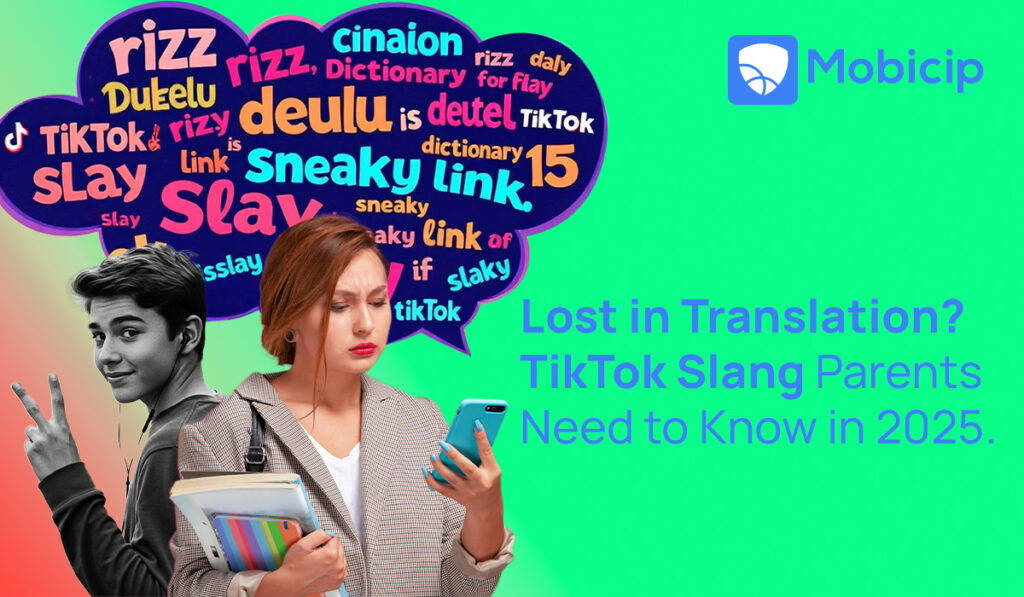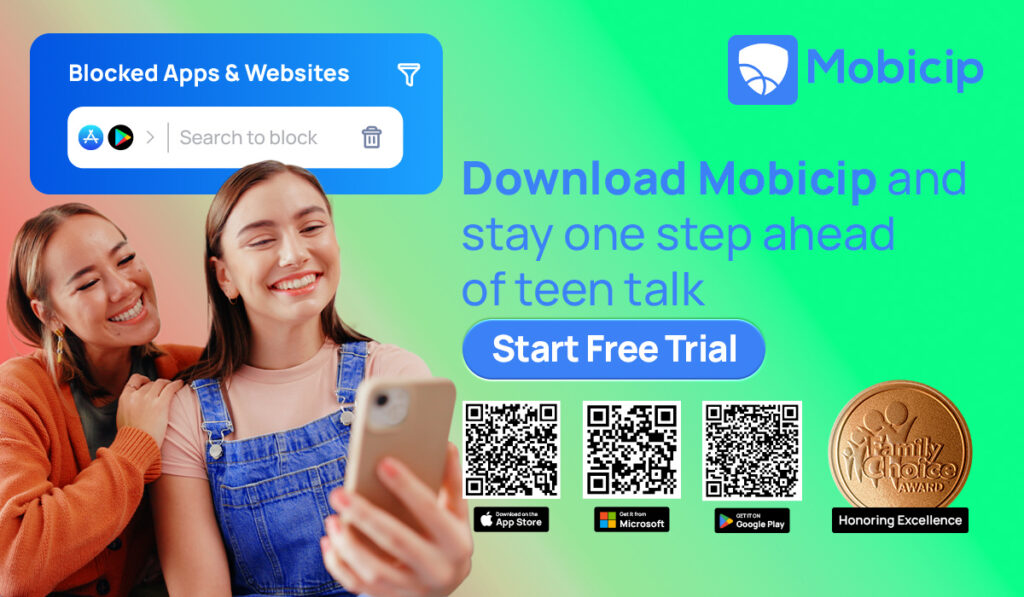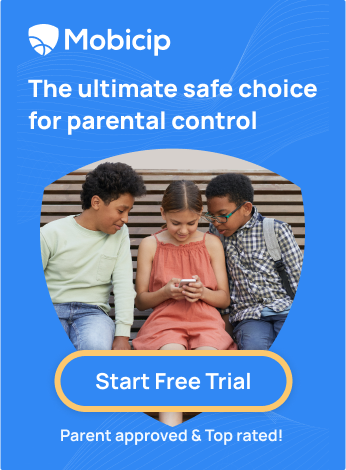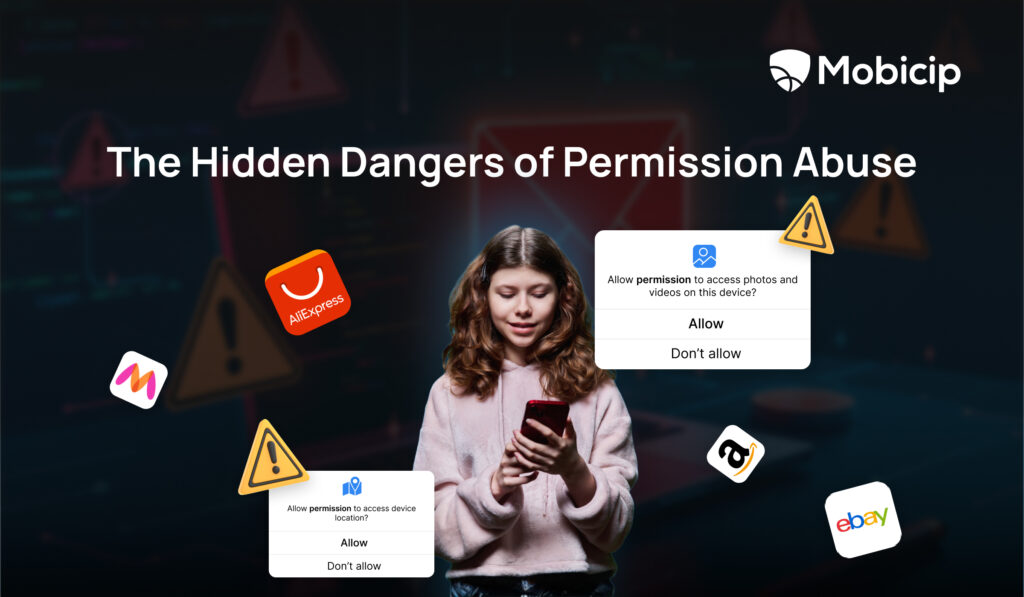Popular TikTok Slang Parents Need to Know in 2025

TikTok slang is a fast-evolving mix of made-up words, abbreviations, and inside jokes that teens use to communicate—and confuse every adult within earshot. If your teen just said something was a “rizz-fail” and you’re wondering whether to call a doctor or a therapist, it might be time to brush up on TikTok slang.
Before we crack open the Gen Z and Gen Alpha slang book, let’s talk about why this matters. TikTok is where many kids live their online lives and they’ve created a language of their own to go with it. There’s nothing new about slang being a social marker of youth. Remember schwing, shiznit, da bomb, and phat that we used as teens in the 80/90’s?
Tiktok slangs may be gibberish for the ancients like us, but it’s how they bond, belong, and broadcast their digital identity. Speaking the same language (or at least understanding it) can go a long way in building trust and connection. And in protecting them from harm.
In this article, we’ll decode the top TikTok slang of 2025, explain what it really means, and show you how to use this knowledge to spark better conversations at home. We’ll also show you how to use Mobicip to protect your child, and stay one step ahead in a digital world where trends change faster than you can say “no cap.”
The Rise of TikTok Slang: A Cultural Shift
What started as a lip-syncing and dance app has quickly evolved into the cultural nerve center of the digital world. TikTok is no longer just a space for viral choreography—it’s where trends are born, social commentary spreads, and new forms of expression take shape.
Here’s a quick look at who’s actually on the app in the U.S. as of 2024:
- Gen Alpha (under 18): Not officially counted, but widely active through shared or supervised accounts
- Gen Z (18–24 years): 25%
- Millennials (25–34 years): 35%
- Gen X (35–44 years): 19%
- Older Gen X / Boomers (45–54 years): 13%
- Boomers+ (55+ years): 14%
Gen Alpha vs. Gen X: A Generational Divide in TikTok Use
Gen Alpha, born into a fully digital world, treats screens like second nature. Their TikTok use leans toward interactive, playful content with bright visuals and short formats. They often access the app through supervised accounts, with parents acting as gatekeepers. They also toggle between YouTube Kids, voice-controlled assistants, and learning apps. .
Gen X, on the other hand, lived through the analog-to-digital transition. Their TikTok use is more cautious and content-driven. They’re drawn to short, authentic videos that offer value as learning, humor, or news. Many are influenced by millennial values like sustainability and diversity.
In short, Gen Alpha consumes TikTok as play. Gen X uses it with purpose.
The Fast-Moving World of TikTok Slang
TikTok slang doesn’t come out of nowhere. Much of it draws from:
- African American Vernacular English (AAVE)
- LGBTQ+ communities and ballroom culture
- Meme culture and internet humor
These communities have long influenced pop culture, and TikTok simply amplifies their creativity on a global scale.
What makes slang on TikTok so dizzying is how quickly it evolves. A phrase can go viral, get adopted by millions, and become outdated—all in a matter of weeks. Teens coin new words daily, remix old ones, and communicate in ways that feel like an inside joke you weren’t invited to.
For parents, this lightning-fast pace makes it hard to keep up. That’s why staying in the loop isn’t just helpful—it’s essential for keeping conversations open and relevant at home.
Top TikTok Slang Terms Parents Should Know in 2025
You’ve got the background—now let’s get into the words themselves. Here are the top TikTok slang terms your kids are probably using.
Everyday Expressions
These are the daily-use TikTok phrases that show up in casual chats, captions, and comments.
-
FYP (For You Page)
Definition: TikTok’s main algorithmic feed
Usage: “Omg I made it to her FYP!”
Context: Getting on someone’s FYP means the algorithm is working its magic—aka, you’re viral. -
POV (Point of View)
Definition: A storytelling format to show a scenario from a specific angle
Usage: “POV: You’re the last slice of pizza at a party”
Context: Often used in skits, memes, or mini-dramas. -
It’s giving…
Definition: Describes a vibe, aesthetic, or impression
Usage: “It’s giving main character energy”
Context: Inspired by LGBTQ+ culture, now mainstream. -
No cap
Definition: I’m being honest / no lie
Usage: “That movie was terrible, no cap”
Context: The opposite of “capping” (lying). -
Bet
Definition: Agreement or confirmation
Usage: “You wanna go to the mall?” “Bet.”
Context: Like saying “Sure” or “Cool.”
Relationship & Identity Slang
When it comes to love, crushes, and friendship, TikTok has its own emotional dictionary.
-
Simp
Definition: Someone who goes overboard for someone they like
Usage: “He bought her lunch again? Total simp.”
Context: Sometimes used playfully, sometimes mockingly. -
Delulu
Definition: Being delusional in a funny or exaggerated way
Usage: “I think he looked at me. We’re basically engaged. I’m so delulu.”
Context: Embracing fantasy, often ironically. -
Rizz
Definition: Charisma, charm, especially in flirting
Usage: “He’s got zero rizz.”
Context: Short for “charisma,” now used like a verb: “He rizzed her up.” -
Bestie
Definition: A term of endearment, not always literal
Usage: “Yes bestie, get that job!”
Context: Used affectionately with friends—or even strangers. -
Ship
Definition: To hope two people get together
Usage: “I totally ship them.”
Context: Short for “relationship,” often used by fans.
Trendy & Viral Phrases
These are buzzwords that ride the wave of TikTok trends—used to react, hype, or roast.
-
Slay
Definition: To do something amazingly well
Usage: “She slayed that outfit.”
Context: Originated in drag culture, now everywhere. -
Cheugy
Definition: Outdated, trying too hard
Usage: “Skinny jeans? That’s kinda cheugy.”
Context: Millennials beware. -
Gyatt
Definition: An exclamation at someone’s appearance, especially curves
Usage: “GYATT—did you see her walk by?”
Context: Meme-heavy and mostly used by younger boys. -
Say sike rn
Definition: “Please tell me you’re joking”
Usage: “They cancelled the concert? Say sike rn.”
Context: A sarcastic way to express disbelief. -
It’s the ___ for me
Definition: Highlighting a specific trait or behavior
Usage: “It’s the fake laugh for me.”
Context: Can be playful or savage.
Slang with Hidden Meanings Parents Should Watch For
Some slang may seem harmless but can mask risky or inappropriate behavior. Here’s what to look out for:
-
Seggs
Definition: Coded spelling of “sex” to avoid content filters
Usage: “They were talking about seggs on live.”
Context: Often signals mature discussions. -
Corn
Definition: Code for adult content (sounds like “porn”)
Usage: “He’s deep into corn TikTok.”
Context: Used to evade moderation. -
Accountant
Definition: Refers to someone involved in sex work or OnlyFans
Usage: “She’s an accountant now 👀”
Context: Meant to be subtle, but widely understood. -
Sneaky link
Definition: A secret romantic or sexual hookup
Usage: “He left to meet his sneaky link.”
Context: Often hidden from parents or friends. -
Crash out
Definition: Acting impulsively or having a breakdown
Usage: “He’s about to crash out over that breakup.”
Context: Can imply emotional distress or dangerous decisions.
How TikTok Slang Impacts Communication and Safety
Like most things in parenting, TikTok slang is a double-edged sword—part charming, part chaotic.
The Upside of TikTok Slang: Creativity, Connection, and Linguistic Growth
While TikTok slang may seem chaotic (and occasionally incomprehensible), it’s actually doing some impressive linguistic heavy lifting. Rather than “ruining” the English language, slang is constantly adding to it. In fact, internet culture has contributed thousands of new words and expressions over the past two decades—some of which vanish quickly, and others that stick around and enrich how we communicate.
- Slang acts like digital dialects, giving online communities (like those on TikTok, Reddit, or Tumblr) a unique voice and identity.
- It enables young people to express themselves creatively, bond with peers, and even build new cultural norms.
- Much of today’s slang is borrowed from rich linguistic traditions like African American Vernacular English (AAVE) and LGBTQ+ communities, helping broaden exposure to dialects and voices that many might not otherwise encounter.
- Creating and using slang requires an intuitive understanding of grammar and nuance—it’s not “bad English,” but rather a new, dynamic form of expression.
So yes, “rizz” and “delulu” might sound ridiculous to the untrained ear, but they’re proof that language is alive, adaptive, and kind of brilliant.
Where TikTok Slang Gets Tricky
But let’s be real—while slang can build bridges among peers, it can also create walls between parents and teens. If you don’t understand the language your child is using, you might miss critical clues about their well-being or online activity.
Here’s where things can get complicated:
- Overuse of slang can sometimes hinder the development of formal writing and communication skills—especially when those skills aren’t being reinforced elsewhere.
- When kids use slang that parents don’t understand, meaningful conversations can break down. Teens may feel misunderstood, and adults may feel shut out.
- A single slang term can carry multiple meanings depending on context. For instance, “sneaky link” might sound innocent unless you know it refers to a secret hookup.
- Casual, unfiltered nature of internet slang can erode respect for clear, precise language—especially in academic or professional settings.
- Some slang is designed to fly under adult radar. Terms like “corn,” “accountant,” or “crash out” may hide inappropriate or harmful behaviors if parents aren’t aware of their true meanings.
Not all slang is harmful—but ignorance can be. Understanding the language of TikTok isn’t just about keeping up. It’s about keeping kids safe, seen, and heard.
Tips for Parents to Stay Updated and Engaged
Staying connected starts with staying curious. Slang is more than wordplay; it’s a peek into how kids think, feel, and connect. Here’s how to stay in the loop without becoming “cringe”:
- Keep the conversation open. Talk to your kids regularly about what they’re seeing online. Ask questions out of curiosity, not criticism.
- Build your own “slang cheat sheet.” Jot down new terms you hear or spot online. There are also great slang dictionaries and TikTok explainers to help decode what’s trending.
- Follow the culture. Subscribe to blogs, follow creators who break down Gen Z/Alpha slang, and keep an eye on what’s bubbling up on your child’s feed.
- Be curious, not clueless. If you hear a new term, ask your teen what it means. Chances are, they’ll be more than happy to educate you—if they know you’re listening without judgment.
- Use tools like Mobicip. Mobicip’s blog and parental control tools help you stay informed, manage screen time, and understand the digital world your kids live in—slang and all.
How Mobicip Can Help
Navigating TikTok slang and digital trends doesn’t have to be overwhelming—Mobicip is here to make it easier. As a trusted parental control and digital safety platform, Mobicip helps you stay informed, involved, and in sync with your child’s online world.
Here’s how Mobicip supports you:
- Content Monitoring: Mobicip helps you understand what kind of content your child is engaging with—including videos, chats, and even slang-heavy posts.
- Screen Time Management: Set healthy limits for TikTok and other apps to encourage balance between online and offline life.
- App & Website Filtering: Block or allow specific apps and websites, so your child sees only age-appropriate content.
- Activity Reports: Get regular updates on your child’s digital habits, including trends or changes that may need a conversation.
- Educational Resources: From blog posts to parent guides, Mobicip keeps you up to date on online slang, safety tips, and digital parenting best practices.
With Mobicip, you don’t have to guess what’s happening—you’ll know. And that knowledge is key to keeping your child safe, supported, and heard in their digital world.

Conclusion
While you might not start dropping “rizz” into dinner conversations (please don’t), understanding their language gives you a passport into the world of your teenage kids. It’s not about being cool—it’s about being present. Because the more you know, the more they’ll know you’re paying attention. And that, in any language, is a big win.





